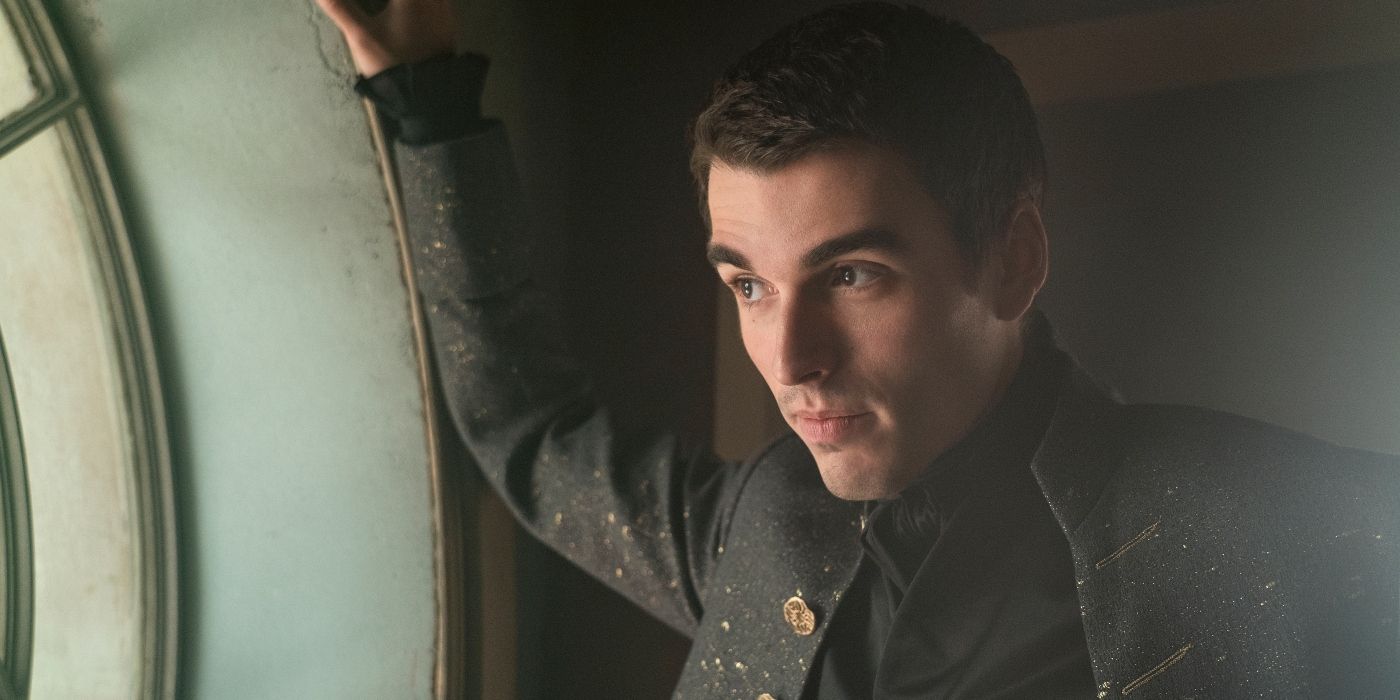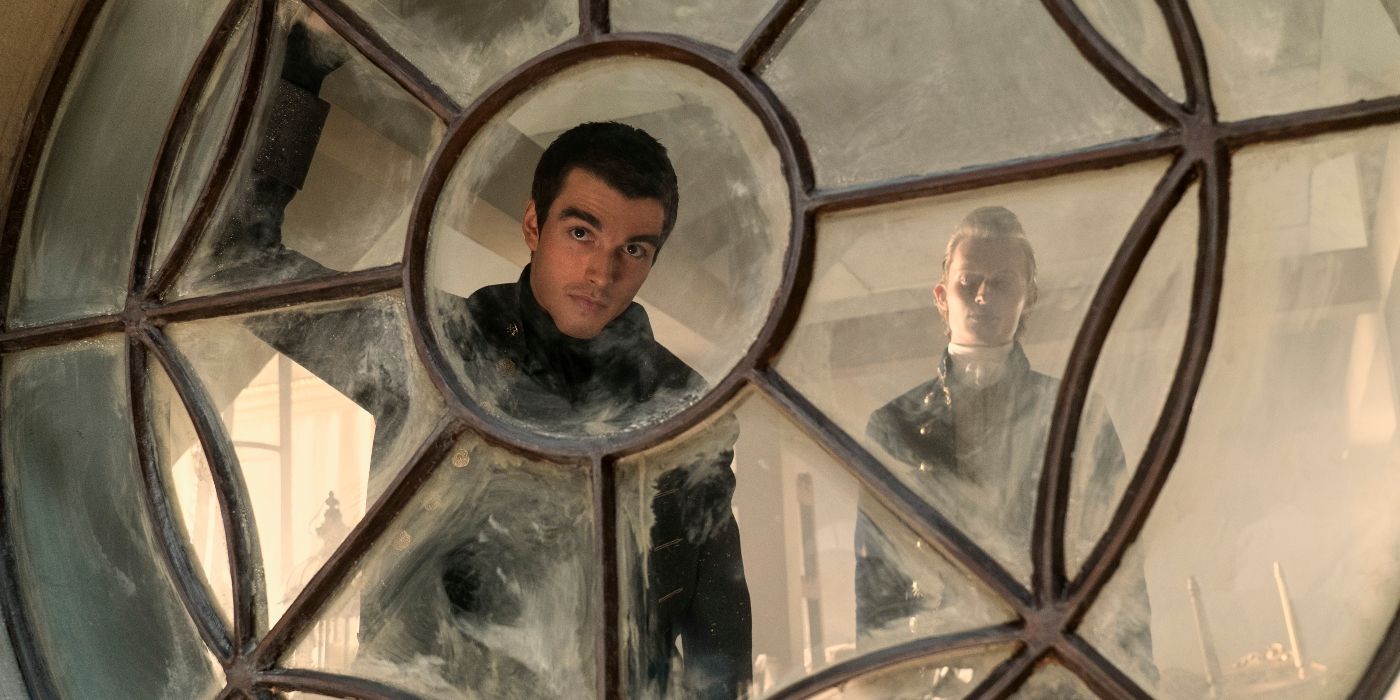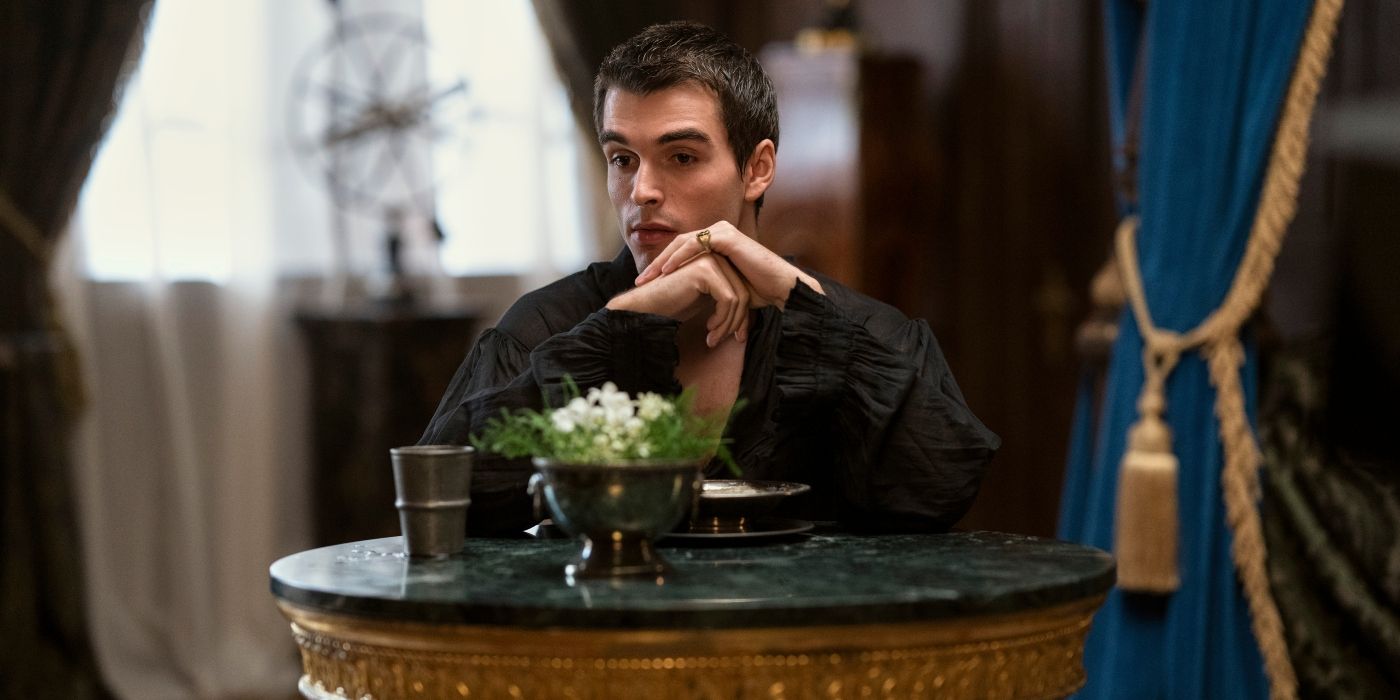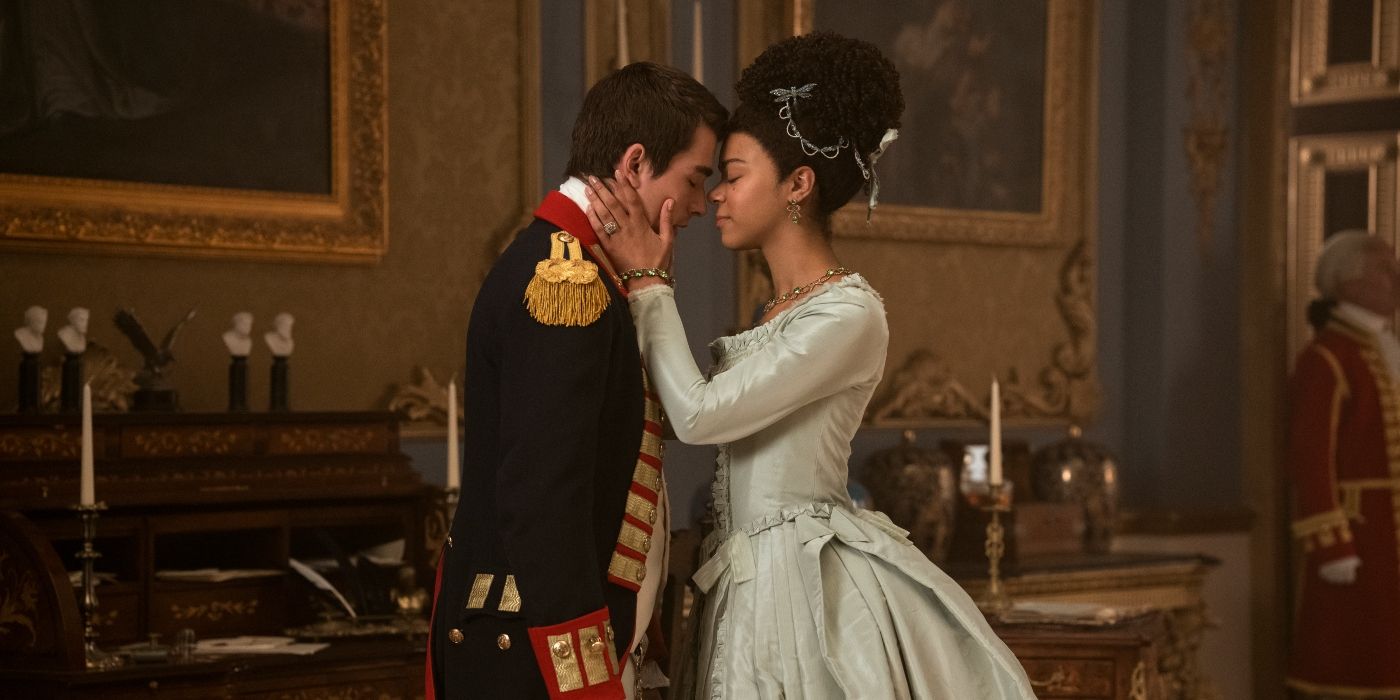Editor's note: The below contains spoilers for Queen Charlotte: A Bridgerton Story.Episode 4 of Queen Charlotte: A Bridgerton Story is a truly shocking, heartbreaking thing to behold — and definitely something fans weren't expecting to see coming out of the Bridgerton universe. After all, the original show based on the series of books by Julia Quinn is usually filled only with light-hearted romance. No one would ever be able to predict that its first spin-off would feature a whole hour of its romantic lead being tortured to exhaustion by a half-sadistic, half-well-intentioned physician. The romantic lead in question is none other than the titular queen's (India Amarteifio) husband, King George III (Corey Mylchreest). The reason for his suffering? His bouts of hallucination and disorganized speech result from a mysterious, poorly comprehended mental illness.
Well, maybe we should've seen it coming. Stories about "mad King George" have been making the rounds in history and story books alike ever since the 18th century. The monarch's mental instability has been the theme of many films and TV series about the British Regency period, the most famous of which is definitely Nicholas Hytner's 1994 movie The Madness of King George, in which Nigel Hawthorne plays a George III plagued by episodes of delusion and paranoia. Bridgerton itself had already touched on the subject of the king's mental health, featuring him (as played by James Fleet) in a Season 2 episode in which he bursts into a meeting held by his wife (Golda Rosheuvel), speaking incoherently and scaring the queen's ladies in waiting. Thus, if a show's purpose is to tell the story of the budding romance between George III and Queen Charlotte, touching on the subject of the king's "madness" is certainly inevitable.
But how much of what appears in Netflix's new hit series is actually true? After all, even though Queen Charlotte is based on a real-life story, writers Shonda Rhimes and Nicholas Nardini have definitely taken some liberties to bring it to the screen. So was King George actually "mad"? Was he actually submitted to inhuman treatment by cruel doctors such as Monro (Guy Henry)? And did his illness actually impact his relationship with Charlotte? The answer to all of these questions is yes. However, that doesn't mean that Queen Charlotte hasn't tinkered with one historical fact or two when it comes to turning George III into its tormented heartthrob.
How Is King George III Depicted in 'Queen Charlotte'?
King George makes his first appearance in Queen Charlotte right in Episode 1 when he runs into his distressed bride trying to run away from the wedding. At first, he comes off as charming, suave, and gentlemanly as he comforts Charlotte and assures her that marrying him should be her choice. However, once the ceremony is over, things quickly take a turn for the worst. After taking Charlotte to her new residence at Buckingham House — later renamed Buckingham Palace — George reveals that he doesn't plan on spending his honeymoon beside his wife. Instead, he shall spend the first few weeks of their marriage completely alone at his own residence, in Kew.
Charlotte is, of course, distraught. Through the first two episodes of Queen Charlotte, the young monarch tries to find a way to bring her husband to her side and suffers as she wonders what could possibly be wrong with her. George, on the other hand, remains firm on his position, seemingly preferring to spend his days looking at the stars and farming for fun instead of sharing a bed with his wife. But, after a series of heated debates filled with romantic and sexual tension, the young king finally acquiesces and moves in into Buckingham House.
George and Charlotte share a somewhat contentious, albeit not unpleasant honeymoon as they try to produce a royal heir partly out of duty, but also because they really enjoy being with one another. But things are never exactly easy for the couple, and it all becomes even more complicated when Charlotte witnesses George having a strange episode. The event takes place at the end of Episode 3: Queen Charlotte awakens to find her husband roaming through the palace with no clothes on, mumbling incoherently about the planet Venus. She follows him to the garden, trying to bring him back to his senses, but it is only by playing along and pretending to be Venus herself that she's able to convince him to come inside.
Aptly titled "Holding the King," Episode 4 of Queen Charlotte reintroduces us to the events of Episodes 1 through 3 now from the point of view of George. We are given insight into the king's own reasons for avoiding his wife, as he struggles with frequent mental breakdowns that leave him unable to control his manner of speech and even his movements. In order to make himself healthy for Charlotte, he accepts to be treated by a proto-psychiatrist by the name of Doctor Monro, who employs violent methods to get His Majesty back to his senses.
Monro's unusual — by both our standards and the standards of the time — form of therapy involves restraining George, beating him whenever he begins to act erratically, and drowning him in iced baths. Unsurprisingly, it doesn't work. Though George does experience some improvement, with time, his illness becomes worse. Eventually, as had already been shown in Bridgerton, he loses complete control of himself. George is declared unfit to rule and his eldest living son, Prince George (Ryan Gage), becomes Prince Regent of the United Kingdom.
The Real King George Suffered from a Mysterious Mental Illness
Prince George acted as regent from 1811 to 1821, when he was crowned King George IV following his father's death. His time as the de facto ruler of the United Kingdom became known as the Regency Period, the setting to many Jane Austen and Austen-inspired texts, from Pride and Prejudice to Bridgerton itself. However, the events that led to Prince George's premature rise to power started a long time before the Regency Act of 1811. But, unlike what is shown in Queen Charlotte, the imminent crisis wasn't evident from the moment George III became king. If, in the series, George is shown to suffer from severe episodes of an unknown mental illness before his wedding to Charlotte, in real life, it was only four years into the marriage and five years after his coronation that the first symptoms began to appear.
King George was merely 27 years old when he experienced his first mental breakdown, in 1865. According to reports from the time, he suffered from an intense fever, accompanied by equally harsh coughing fits. These physical symptoms were followed by sudden weight loss, bursts of insomnia, and severe cognitive impairment. The episode caused fear in the court and in the House of Parliament. An act was passed to install a regency if something like it ever happened again, but it was soon repealed when George recovered his senses.
23 years later, however, this strange disease would not only come back, but its outbursts would become much more frequent and intense. In 1788, during another episode, the king, who was known to those close to him as a kind and gentle man, became suddenly rude and began to sexually harass the women at Windsor Castle. Furthermore, he suffered from hallucinations, disorganized speech, and violent convulsions. In a report written by one of his servants, Robert Greville, it is said that King George spent Christmas Day of 1788 holding a pillow he believed to be his son, Prince Octavius.
This relapse led to a power crisis in George III's court. In parliament, the opposition called for a regency that would see Prince George as ruler in lieu of his father. Meanwhile, the Tories, that had command of the house at the time, tried to avoid the regency at all costs. In his private life, George retreated to Kew to treat his unknown illness, which doctors from the time believed to be caused by an imbalance of the four humours. In order to restore this balance, the king was submitted to inhumane treatments involving arsenic powder, leeches, purgatives, and ice baths, much like what is shown in Queen Charlotte.
These so-called treatments, however, didn't work, and soon after her husband's 1788 episode, the real Queen Charlotte asked for the help of a doctor and minister by the name of Francis Willis. Willis, who seems to represented in the show by Dr. Monro's character, was known for treating cases of insanity in his private asylum, in Lincolnshire. According to his own set of believes, all cases of mental illness could be resolved with strict control of the patient's behavior. In order to control King George, Willis had him frequently put in straitjackets and prohibited him from seeing members of his family whenever he was "misbehaving." Monro's decision to feed George nothing but a disgusting grub is also based on one of Willis' treatments: during his episodes, the king was only allowed to eat mushed-up food with a wooden spoon.
George III did recover from this episode in 1789, and the regency crisis was averted. However, it's pretty hard to believe that Willis' methods had anything to with it. Still, the doctor was awarded £1,500 a year for 21 years for his services and eventually opened up a second asylum, much to his patients' chagrin. The king, in turn, relapsed once more in 1801. And then once again in 1804. In 1810, at the age of 71, he suffered his fifth mental breakdown. From this one, however, he would never recover. Nearly blind due to cataracts and possibly suffering from dementia, he spent the last ten years of his life completely unaware of the world around him. When Queen Charlotte died, in 1818, it is said that he didn't mourn her because he simply didn't know who she was.
What Did King George Suffer From?
Up to this day, researchers aren't sure of what caused King George's "madness." However, there are some theories surrounding it. For a long time, the most accepted one was that His Majesty suffered from porphyria, a genetic condition with symptoms that include physical pain, insomnia, and mental instability. This theory was proposed in the 1960s by psychiatrists Ida Macalpine and Richard Hunter, and its most damning evidence is the medical reports concerning the color of George III's urine, which had a blueish tint, pretty common among porphyria patients.
However, in 2013, research conducted by Doctors Peter Garrard and Vassiliki Rentoumi at the University of London concluded that George III's affliction was not genetic, but psychiatric in origin. While analyzing letters written by the king during his episodes, the researchers found that his sentences had a tendency to become unusually long. Some contained up to 400 words and eight verbs. The same pattern, Garrard and Rentoumi say, can be found in writings by psychiatric patients going through periods of mania provoked by illnesses such as bipolar disorder. According to a BBC story on Garrard and Rentoumi's research, “George's being in a manic state would also match contemporary descriptions of his illness by witnesses. They spoke of his 'incessant loquacity' and his habit of talking until the foam ran out of his mouth." As for the blue urine, well, apparently one of George's many treatments included a medicine made of gentian, a deep blue flower that may have this effect on those that consume its extract.
It's a pretty good theory, but, in the end, we're still not sure of what exactly was going on with King George. We probably never will be. The only thing we know for certain is that, whatever his disease was, it sure shouldn't have been treated with leeches and straitjackets.
Queen Charlotte: A Bridgerton Story is now available to stream on Netflix.




